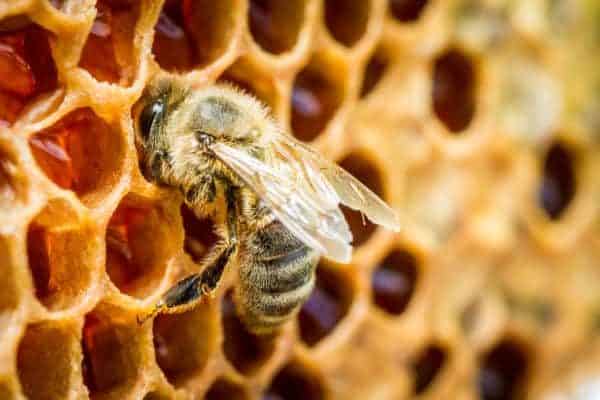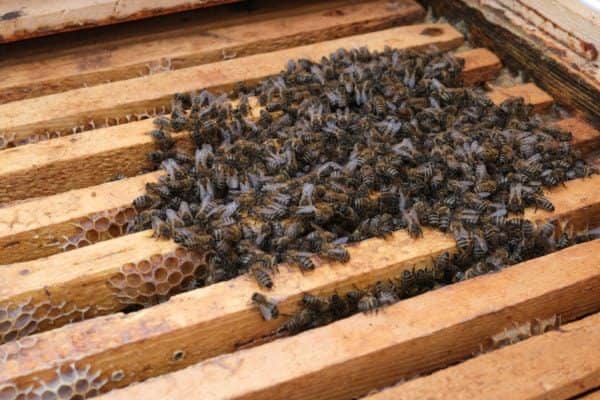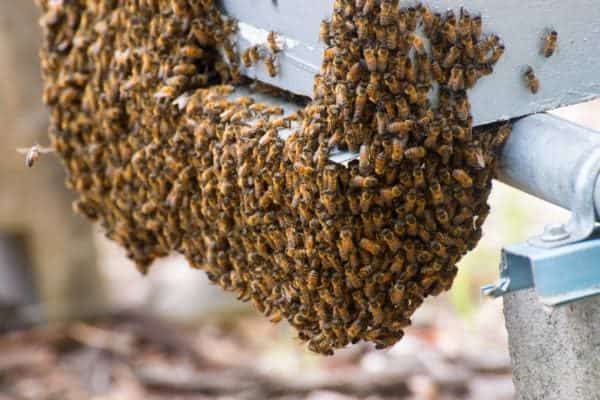Whether you already keep bees or are about to take the first steps in your beekeeping journey, you probably want to know how much honey each of your bees can produce, right? Well, luckily, we’ve done the hard work for you.

So, how much honey can one little bee make in its lifetime? Well, based on our research, an average honey bee will make around 1/12 of a teaspoon of honey before it dies. This is just 0.35 of a gram or 0.013 of an ounce! There are some factors that influence this, seasonality, hive size, hive health, availability of nectar, and location of the hive.
I know you already thinking how many bees to make a pound or kilogram or honey? To save you the time check out the table below:
| Honey By Weight | Number Of Bees Needed To Make The Honey |
| 1 Ounce | 77 Bees |
| 1 Pound | 1,230 Bees |
| 2 Pounds | 2,460 Bees |
| 5 Pounds | 6,150 Bees |
| 12 Pounds | 14,760 Bees |
| 1 Gram | 3 Bees |
| 500 Grams | 1,429 Bees |
| 1 Kilogram | 2,857 Bees |
| 2 Kilograms | 5,714 Bees |
| 5 Kilograms | 14,285 Bees |
Incidently if you were to buy a 1 gallon pale of honey it would typically weigh 12 pounds. Weigh does vary a little depending on the variety of honey.
Having read the number bees it takes to make these quantities of honey it is important to note that there are factors that will influence the yield of honey a bee can produce. But first, it helps to know which of your honey bees are responsible for making honey.
Do All Honey Bees Make Honey?
Whilst it’s true that honey bees work together like a well-oiled machine, Not every bee is involved in the production of honey. Instead, their hives are made up of:
- a queen bee who lays eggs and uses her pheromones to keep the hive working together
- 100s of male drones whose primary job is to mate with a queen whilst out on their mating flights.
- 1000s of female worker bees who spend their lives caring for the hive, collecting nectar and pollen, and making honey.
And that means that when we talk about how much honey bees can produce, we are really asking is:
“How much honey can a worker bee make during her lifetime?”
So, let’s look at the factors which affect how much honey each worker produces. Starting with the different breeds of honey bees:
The Different Types Of Honey Bee
Whilst there are nearly 20 000 species of bees in the world, only a small number of these fantastic minibeasts have the ability to produce honey.
These bees are known under the scientific name of ‘Apis’.
Now, within the genus ‘Apis’, seven species of honey bee exist. But it is from the Species ‘Apis Mellifera’ otherwise known as the ‘Western honey bee’ that most breeds of domesticated honey bees belong.
We have some other articles about bees and other insects and their ability to make honey. Check these out if you are interested:
Vulture Bees: There Are Meat Eating Bees And They Make Honey
Carpenter Bees Vs Bumblebees Vs Honey Bees
Back to honey bees, you see like with dogs, humans have selectively bred bees for desirable characteristics like honey production, lack of aggression, and hardiness. And this has led to multiple recognizable breeds like:
The Italian Honey Bee
The Italian honey bee is very popular, and with good reason- these busy, busy bees are known to produce the most honey of all the domesticated honey bees.
The Caucasian Honey Bee
Unlike the Italian bee, the Caucasian is known to have a low honey yield. Though it’s not all bad news, they are known to be extremely gentle!
The Carniolan Honey Bee
Though not quite as high as the Italian, the Carniolan honey bee is considered to have a good honey yield and they are gentle too. Be warned though, this breed is known to swarm more often than other breeds.
The Russian Honey Bee
Bred to be resistant to mites, the Russian honey bee is a moderate honey producer.
The Buckfast Honey Bee
Like the Carniolan honey bee, the Buckfast is considered to be a good producer of honey, and they are relatively mite resistant too. However, they do have a tendency for aggression that can make harvesting that honey a little tricky!
OK, so we’ve seen how the breed of bee can affect honey production, so what’s next?
Does Weather Effect How Much Honey A Worker Bee Can Make?
When we consider that bees need flowers to make honey, it’s clear to see that hive production will be affected by how much warm weather you receive. After all, few flowers thrive in freezing temperatures and honey bees do lie dormant over the winter months.
But it is not just a hives honey yield that is affected by the weather. The productivity of individual bees is also dependent on the weather.
Because individual bees only live for a matter of weeks the following weather conditions can have a significant effect on the amount of honey that bees can produce:
- When Storm Events Occur
- When There Is A Cold Snap
- When There Is A Heatwave
1. When Storm Events Occur
Not only does rain make it difficult for bees to fly, but storms also bring strong winds which can pose a real threat to hives. To guard against structural damage and floods, worker bees must stormproof their homes whenever a storm approaches. To do this, they fill any crevices in the hive with a special substance called ‘propolis’.
Of course, the more time spent protecting their hive from storms, the less time available for harvesting nectar and turning it into honey.
2. When There Is A Cold Snap
Have you ever noticed that honey bees are absent from the garden in cold spells? Well, that’s because they are huddled together for warmth in the safety of their hives.

And if they are huddled inside their hives, precious little foraging is taking place!
3. When There Is A Heatwave
Worker bees are in charge of maintaining an ambient temperature within their hive. This means that when the weather is hot, some bees need to remain at home in order to cool the hive.
They do this by creating a kind of air conditioning by excreting water and using their wings to fan it around the hive. As heat causes this water to evaporate, it cools the air and keeps conditions comfortable within the hive (pretty neat, huh?).
In very hot weather bees will hang outside of the hive trying to keep their hives cool. This is called bearding. The picture below is an example of bearding.

Unfortunately, all this work leaves bees with less time to dedicate to collecting honey.
OK, so what else can affect a honey bee’s lifetime honey production?
Food Sources And Honey Production
It goes without saying that the availability of nectar affects the amount of honey a honey bee can produce over its lifetime. After all, the greater the distance between flowers, the longer each foraging trip will take.
But it is not just the quantity of flowers that matter, the quality matters too.
And that’s why back garden beekeepers are so keen to plant high nectar species like:
- Cornflowers
- Sunflowers
- Comfrey
The Wrap Up
Well, because the amount of honey an individual bee can make in its lifetime is dependent on so many factors, it is impossible to say with any certainty how much honey a single honey bee will produce.
And remember, whilst you can’t control the weather, you can give bees a helping hand by planting some of their favorite flowers in your garden!
Sources
https://content.ces.ncsu.edu/the-different-types-of-honey-bees
https://www.worldatlas.com/articles/the-seven-species-of-honey-bees-living-today.html
http://entnemdept.ufl.edu/creatures/MISC/BEES/euro_honey_bee.htm
